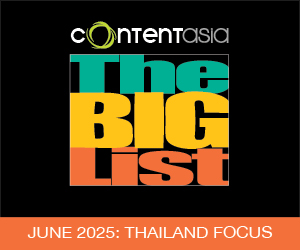
Taiwanese producer, Patrick Mao Huang, is having an especially busy year, with several new ventures in XR filmmaking and a triumphant win at Cannes as co-producer of "Tiger Stripes", which clinched the Grand Prize at the Critics’ Week.
Huang’s "Colored", a co-production between his company Flash Forward Entertainment and France’s Novaya, was one of two immersive projects from Taiwan nominated in New Voices Competition at the Tribeca Film Festival’s immersive section in June. Both were highlighted for their creativity, technical capabilities, and market potential.
Huang first heard an online pitch for "Colored" from Novaya at Sunny Side of the Doc in 2021. Set in Alabama in the 1950s, the film is about 15-year-old Claudette Colvin, who refused to give up her seat to a white passenger. Exploring racial identity and ethnic issues, the film is supported by the Immersive Content Grant from the Taiwan Creative Content Agency (Taicca).
How does Augmented Reality (AR) enhance the story you were trying to tell with "Colored"? “Watching this story with the Microsoft HoloLens 2, you can see the image of the character immersed within real furniture and environment, which is very fascinating. You can sit down on a bench with the character and experience the same thing. Since the subject is about prejudice and discrimination, you can really feel how the character felt when a finger is pointed at you, telling you to stand up and go away. You are under the same pressure and situation as the character.”
What are some challenges that you faced while making "Colored"? “We used live characters. It is not animated, so we did volumetric scanning at a Taiwanese facility founded by Taicca. Colored is the biggest project for this lab so far. They have done a lot of music videos, commercials and some short XRs, but our film is more than 30 minutes and we have around 20 characters. How do we control the time and budget to support this 20-character scan? There were many restrictions that I had not experienced before. For example, the fabric had to be a certain colour, if not it will affect the scanning. For the hairstyle, it had t...
Taiwanese producer, Patrick Mao Huang, is having an especially busy year, with several new ventures in XR filmmaking and a triumphant win at Cannes as co-producer of "Tiger Stripes", which clinched the Grand Prize at the Critics’ Week.
Huang’s "Colored", a co-production between his company Flash Forward Entertainment and France’s Novaya, was one of two immersive projects from Taiwan nominated in New Voices Competition at the Tribeca Film Festival’s immersive section in June. Both were highlighted for their creativity, technical capabilities, and market potential.
Huang first heard an online pitch for "Colored" from Novaya at Sunny Side of the Doc in 2021. Set in Alabama in the 1950s, the film is about 15-year-old Claudette Colvin, who refused to give up her seat to a white passenger. Exploring racial identity and ethnic issues, the film is supported by the Immersive Content Grant from the Taiwan Creative Content Agency (Taicca).
How does Augmented Reality (AR) enhance the story you were trying to tell with "Colored"? “Watching this story with the Microsoft HoloLens 2, you can see the image of the character immersed within real furniture and environment, which is very fascinating. You can sit down on a bench with the character and experience the same thing. Since the subject is about prejudice and discrimination, you can really feel how the character felt when a finger is pointed at you, telling you to stand up and go away. You are under the same pressure and situation as the character.”
What are some challenges that you faced while making "Colored"? “We used live characters. It is not animated, so we did volumetric scanning at a Taiwanese facility founded by Taicca. Colored is the biggest project for this lab so far. They have done a lot of music videos, commercials and some short XRs, but our film is more than 30 minutes and we have around 20 characters. How do we control the time and budget to support this 20-character scan? There were many restrictions that I had not experienced before. For example, the fabric had to be a certain colour, if not it will affect the scanning. For the hairstyle, it had to be quite constrained and with the character’s movement, we could not cover any part of the body.
We had about five days of rehearsals before we even went to the facility. We then also had to pre-select and process sequences and then upload the big file to the cloud, where our French post-production supervisor downloads them in France to work on.”
"Colored" premiered at the Pompidou Centre this year. What are the challenges you face in AR film exhibition? “Colored is a location-based experience. Not every festival or venue can afford it... You have to pay more for more than just one headset, and the Microsoft HoloLens headset is even more expensive than VR headsets. That’s a big challenge that we are facing now. I’m going to have an exhibition in Taiwan in a few months and we are still working out the budget.”
How do you choose which stories to produce? “The story has to have something new to me, yet something familiar. Tiger Stripes is a coming-of-age story, which is familiar, but it has fantasy elements with the tiger symbols, which is something new. It will be screening at the Bucheon International Fantastic Film Festival. For Colored, the human rights story was a familiar aspect, but we used a new technology called volumetric filmmaking. That’s something I can explore, so I wanted to do that. I have another documentary project which also came from meetings at Sunny Side of the Doc. It is called Slave Island and it discusses the slavery system still operating in Indonesia on Sumba Island. The island is actually full of tourists. It doesn’t look like it, but on the other side of the mountain, there is a village where slavery is happening. There’s always something hidden and my job as a film producer is to discover the stories from this hidden world.”
– by Sara Merican





























